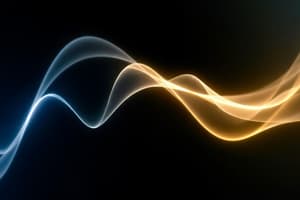Podcast
Questions and Answers
What factor primarily influences the emission of electrons in the photoelectric effect?
What factor primarily influences the emission of electrons in the photoelectric effect?
- Frequency of light (correct)
- Color of light
- Duration of light exposure
- Intensity of light
Which optical instrument directly uses lenses to magnify images?
Which optical instrument directly uses lenses to magnify images?
- Mirror
- Optical fiber
- Telescope (correct)
- Laser
What type of cells in the human eye are responsible for color perception?
What type of cells in the human eye are responsible for color perception?
- Cones (correct)
- Rods
- Bipolar cells
- Ganglion cells
Which of the following is NOT an application of optics?
Which of the following is NOT an application of optics?
What concept, introduced by Einstein, describes light as discrete energy packets?
What concept, introduced by Einstein, describes light as discrete energy packets?
Which color of visible light has the longest wavelength?
Which color of visible light has the longest wavelength?
What is the phenomenon called when light travels in straight lines?
What is the phenomenon called when light travels in straight lines?
What type of reflection occurs on smooth surfaces producing clear images?
What type of reflection occurs on smooth surfaces producing clear images?
What describes the bending of light as it passes from one medium to another?
What describes the bending of light as it passes from one medium to another?
What is the term for the principle where the angle of incidence equals the angle of reflection?
What is the term for the principle where the angle of incidence equals the angle of reflection?
Which of these best describes diffraction?
Which of these best describes diffraction?
What is the property of light that describes the orientation of electric field oscillations?
What is the property of light that describes the orientation of electric field oscillations?
Which phenomenon demonstrates the particle-like behavior of light?
Which phenomenon demonstrates the particle-like behavior of light?
Flashcards
Electromagnetic Spectrum
Electromagnetic Spectrum
A form of electromagnetic radiation, encompassing a wide range of wavelengths and frequencies, including radio waves, microwaves, infrared radiation, visible light, ultraviolet radiation, X-rays, and gamma rays.
Visible Light
Visible Light
A small portion of the electromagnetic spectrum, encompassing wavelengths visible to the human eye, ranging from red to violet, with longer wavelengths for red and shorter for violet.
Refraction
Refraction
The bending of light as it passes from one medium to another, caused by a change in the speed of light between the two media.
Reflection
Reflection
Signup and view all the flashcards
Diffraction
Diffraction
Signup and view all the flashcards
Polarization
Polarization
Signup and view all the flashcards
Wave-Particle Duality
Wave-Particle Duality
Signup and view all the flashcards
Speed of Light
Speed of Light
Signup and view all the flashcards
What is the photoelectric effect?
What is the photoelectric effect?
Signup and view all the flashcards
Why does the frequency of light, not the intensity, determine the energy of emitted electrons in the photoelectric effect?
Why does the frequency of light, not the intensity, determine the energy of emitted electrons in the photoelectric effect?
Signup and view all the flashcards
How do optical instruments work?
How do optical instruments work?
Signup and view all the flashcards
How does the color of light affect our perception?
How does the color of light affect our perception?
Signup and view all the flashcards
What are some applications of optics?
What are some applications of optics?
Signup and view all the flashcards
Study Notes
Electromagnetic Spectrum
- Light is a form of electromagnetic radiation.
- The electromagnetic (EM) spectrum encompasses a wide range of wavelengths and frequencies, including radio waves, microwaves, infrared radiation, visible light, ultraviolet radiation, X-rays, and gamma rays.
- Visible light occupies a small portion of the EM spectrum.
- Different colors of visible light correspond to different wavelengths. Red light has the longest wavelength, while violet light has the shortest.
Properties of Light
- Light travels in straight lines in a vacuum or homogeneous medium. This is known as rectilinear propagation.
- Light travels at a constant speed in a vacuum (approximately 299,792,458 meters per second).
- The speed of light in a medium is slower than in a vacuum.
- Light can be reflected, refracted, diffracted, and polarized.
Reflection
- Reflection occurs when light bounces off a surface.
- The angle of incidence equals the angle of reflection.
- Mirrors use reflection to form images.
- Types of reflection include specular (smooth surfaces, producing clear images) and diffuse (rough surfaces, scattering light).
Refraction
- Refraction is the bending of light as it passes from one medium to another.
- The amount of bending depends on the refractive indices of the two media.
- Refractive index is a measure of how much a medium slows down light.
- Examples of refraction include rainbows, lenses, and the apparent bending of objects in water.
Diffraction
- Diffraction is the bending of light as it passes through an aperture or around an obstacle.
- The amount of diffraction depends on the size of the aperture or obstacle relative to the wavelength of light.
- Diffraction patterns are often observed when light passes through a narrow slit or around an edge of an object.
Polarization
- Polarization describes the orientation of the electric field oscillations in a light wave.
- Unpolarized light has electric field oscillations in random directions.
- Polarized light has electric field oscillations in a specific direction.
- Polarizers are used to filter out light with unwanted polarization.
Wave-Particle Duality
- Light exhibits both wave-like and particle-like properties.
- Wave-like behavior is evident in phenomena such as interference and diffraction.
- Particle-like behavior is seen in phenomena such as the photoelectric effect.
The Photoelectric Effect
- The photoelectric effect describes the emission of electrons when light shines on a material.
- The emission of electrons depends on the frequency of the light, not its intensity.
- Einstein's explanation of the photoelectric effect introduced the concept of photons as discrete packets of energy.
Optical Instruments
- Optical instruments utilize the principles of reflection and refraction to manipulate light and create images.
- Examples include microscopes, telescopes, cameras, and eyeglasses.
- These devices use lenses, mirrors, and other optical components to magnify, focus, or redirect light for specific applications.
Color and Vision
- Color perception depends on the wavelength of light that enters the eye.
- Different wavelengths are perceived as different colors.
- The human eye contains specialized cells called cones, which are sensitive to different ranges of wavelengths.
- Cones enable us to see a wider range of colors.
Applications of Optics
- Optics finds applications in a wide range of fields, including communication, medicine, and industrial processes.
- Optical fibers transmit information over long distances.
- Lasers, which use stimulated emission of light, are used in many applications.
- Optical imaging techniques are used in medical diagnostics.
Studying That Suits You
Use AI to generate personalized quizzes and flashcards to suit your learning preferences.




